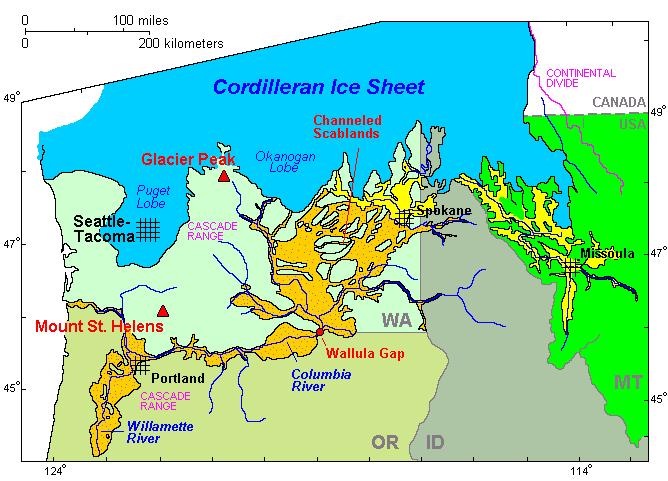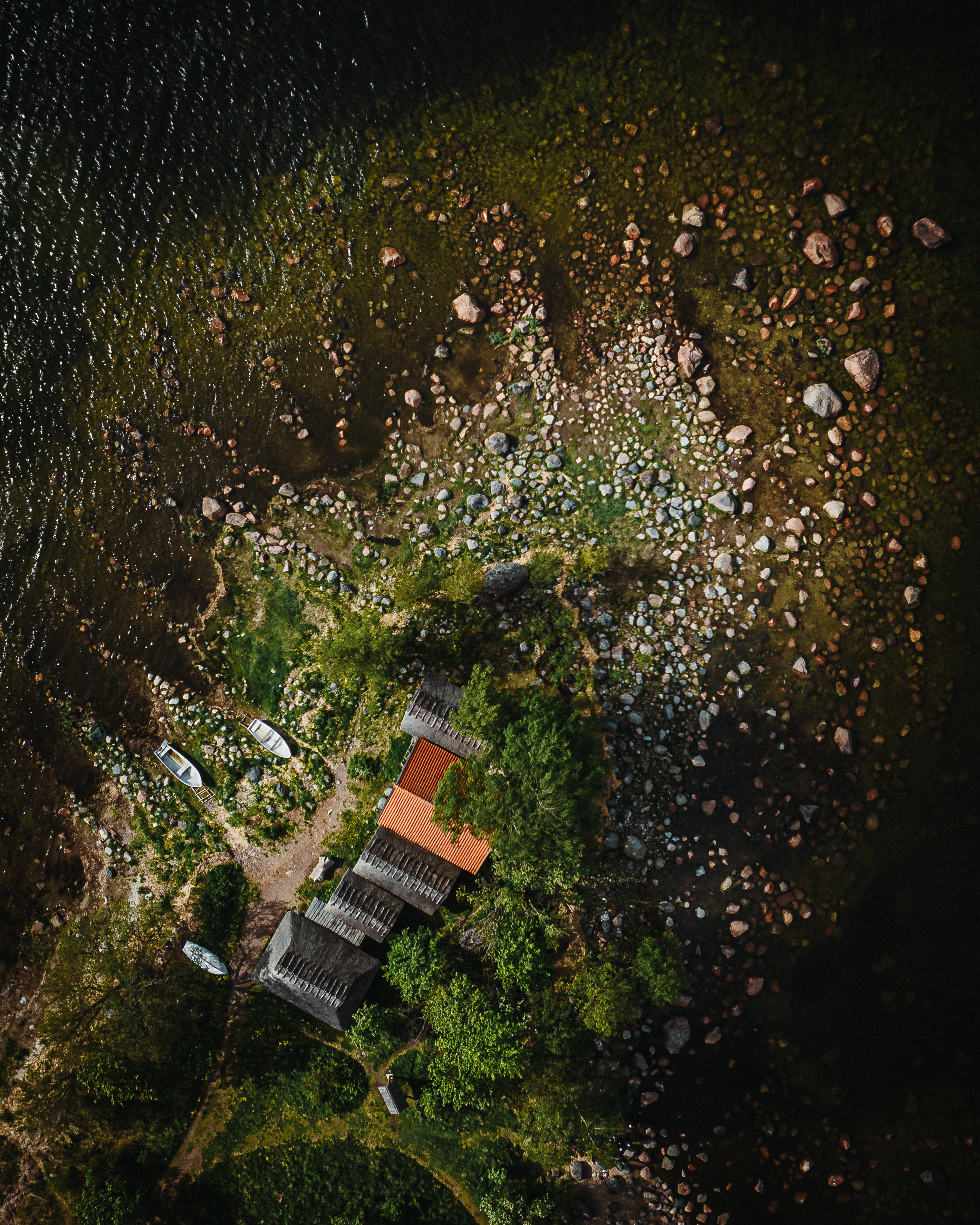|
Grand Coulee
Grand Coulee is an ancient river bed in the U.S. state of Washington. This National Natural Landmark stretches for about southwest from Grand Coulee Dam to Soap Lake, being bisected by Dry Falls into the Upper and Lower Grand Coulee. Geological history Grand Coulee is a large coulee on the Columbia River Plateau. This area has underlying granite bedrock, formed deep in the Earth's crust 40 to 60 million years ago. The land periodically uplifted and subsided over millions of years giving rise to some small mountains and, eventually, an inland sea. From about 10 to 18 million years ago, a series of volcanic eruptions from the Grand Ronde Rift near the Idaho/Oregon/Washington/Montana border began to fill the inland sea with lava. In some places the volcanic basalt is thick. In other areas granite from the earlier mountains is still exposed. Starting about two million years ago, during the Pleistocene epoch, glaciation took place in the area. Large parts of northern North ... [...More Info...] [...Related Items...] OR: [Wikipedia] [Google] [Baidu] |
Dry Falls
Dry Falls is a scalloped precipice with four major alcoves, in central Washington scablands. This cataract complex is on the opposite side of the Upper Grand Coulee from the Columbia River, and at the head of the Lower Grand Coulee, northern end of Lenore Canyon. According to the current geological model, catastrophic flooding channeled water at 65 miles per hour (105 kph) through the Upper Grand Coulee and over this rock face at the end of the last glaciation. It is estimated that the falls were five times the width of Niagara Falls, with ten times the flow of all the current rivers in the world combined. Nearly twenty thousand years ago, as glaciers moved south through North America, an ice sheet dammed the Clark Fork River near Sandpoint, Idaho. Consequently, a significant portion of western Montana flooded, forming the gigantic Lake Missoula. About the same time, Glacial Lake Columbia was formed on the ice-dammed Columbia River behind the Okanogan lobe of the Cordi ... [...More Info...] [...Related Items...] OR: [Wikipedia] [Google] [Baidu] |
Glacial Period
A glacial period (alternatively glacial or glaciation) is an interval of time (thousands of years) within an ice age that is marked by colder temperatures and glacier advances. Interglacials, on the other hand, are periods of warmer climate between glacial periods. The Last Glacial Period ended about 15,000 years ago. The Holocene is the current interglacial. A time with no glaciers on Earth is considered a Greenhouse and icehouse Earth, greenhouse climate state. Quaternary Period Within the Quaternary, which started about 2.6 million years before present, there have been a number of glacials and interglacials. At least eight glacial cycles have occurred in the last 740,000 years alone. Changes in atmospheric and associated radiative forcing were among the primary drivers of globally cold glacial and warm interglacial climates, with changes in ocean physical circulation, biological productivity and seawater acid-base chemistry likely causing most of the recorded changes Penul ... [...More Info...] [...Related Items...] OR: [Wikipedia] [Google] [Baidu] |
Glacial Lake Columbia
Glacial Lake Columbia was the lake formed on the ice-dammed Columbia River behind the Okanogan lobe of the Cordilleran Ice Sheet when the lobe covered of the Waterville Plateau west of Grand Coulee in central Washington state during the Wisconsin glaciation.The Wisconsin glaciation began about 80,000 years ago and ended around 10,000 years ago. Lake Columbia was a substantially larger version of the modern-day lake behind the Grand Coulee Dam. Lake Columbia's overflow – the diverted Columbia River – drained first through Foster Coulee, and as the ice dam grew, then through Moses Coulee, and finally, the Grand Coulee. Glacial Lake Missoula The Cordilleran ice sheet also blocked the Clark Fork River and created Glacial Lake Missoula, rising behind a high ice dam in flooded valleys of western Montana. Over 2000 years the ice dam periodically failed, releasing approximately 40 high-volume Missoula Floods of water down the Columbia River drainage, passing through glacial Lak ... [...More Info...] [...Related Items...] OR: [Wikipedia] [Google] [Baidu] |
Banks Lake
Banks Lake is a reservoir in central Washington in the United States. Part of the Columbia Basin Project, Banks Lake occupies the northern portion of the Grand Coulee, a formerly dry coulee near the Columbia River, formed by the Missoula Floods during the Pleistocene epoch. Grand Coulee Dam, built by the United States Bureau of Reclamation on the Columbia River created Franklin D. Roosevelt Lake, the reservoir on the river behind the dam. The surface of Lake Roosevelt is several hundred feet above the original Columbia River, making it easier to pump water up and out of the river's canyon into the adjacent Grand Coulee. Two low earth-fill dams, Dry Falls Dam and North Dam, keep the water in the Grand Coulee, thus creating the reservoir named Banks Lake. It is named after Frank A. Banks, the construction supervisor at Grand Coulee Dam. At the north end of Banks Lake the city of Grand Coulee and the town of Electric City are located. Steamboat Rock State Park is in the ... [...More Info...] [...Related Items...] OR: [Wikipedia] [Google] [Baidu] |
University Of Idaho Press
Caxton Press (formerly known as Caxton Printers, a division of its parent company, The Caxton Printers Ltd.) is a book publisher located in Caldwell, Idaho, United States, founded in 1925. It is also a distributor of books from the University of Idaho Press, Black Canyon Communications, Snake Country Publishing, Historic Idaho Series and Alpha Omega Publishing. It was founded by J. H. Gipson to give western writers, particularly of non-fiction about the people or culture of the Western United States, a vehicle for publication of their work. History It is the publishing division of The Caxton Printers Ltd., founded in Caldwell in 1895 by A. E. Gipson, as the Gem State Rural Publishing Company, renamed to its present name in 1903. Regular publishing of books began in 1925. The Caxton Printers was named after William Caxton, printer of the first-ever book in English, in 1474. The publishing division was itself named Caxton Printers until around 1995, when it was changed to Ca ... [...More Info...] [...Related Items...] OR: [Wikipedia] [Google] [Baidu] |
Channeled Scablands
The Channeled Scablands are a relatively barren and soil-free region of interconnected relict and dry flood channels, coulees and cataracts eroded into Palouse loess and the typically flat-lying basalt flows that remain after cataclysmic floods within the southeastern part of Washington state.Neuendorf, K.K.E., J.P. Mehl, Jr., and J.A. Jackson, eds. (2005) ''Glossary of Geology'' (5th ed.). Alexandria, Virginia, American Geological Institute. 779 pp. The Channeled Scablands were scoured by more than 40 cataclysmic floods during the Last Glacial Maximum and innumerable older cataclysmic floods over the last two million years. These floods were periodically unleashed whenever a large glacial lake broke through its ice dam and swept across eastern Washington and down the Columbia River Plateau during the Pleistocene epoch. The last of the cataclysmic floods occurred between 18,200 and 14,000 years ago.Balbas, A.M., Barth, A.M., Clark, P.U., Clark, J., Caffee, M., O'Connor, J., B ... [...More Info...] [...Related Items...] OR: [Wikipedia] [Google] [Baidu] |
J Harlen Bretz
J Harlen Bretz (2 September 1882 – 3 February 1981) was an American geologist, best known for his research that led to the acceptance of the Missoula Floods and for his work on caves. Early life and education Bretz was born on 2 September 1882, in the small town of Saranac in Ionia County, Michigan. He was the first of Oliver Joseph Bretz and Rhoda Maria Howlett's five children. His father was a farmer, and proud descendant of early German settler in Ohio, John Bretz. The county's birth registry recorded his name as "Harlan J Bretz" at birth, but he was listed as "Harland J Bretz" on the 1900 United States Census. When he entered college in 1901, he applied as "J Harlen Bretz". At around the time he completed his graduate studies in 1913, he stopped using a point after the initial at "J". According to his two children, his given name was actually "Harley". Bretz's daughter Rhoda Bretz Riley went on to explain that "he invented the Harlen thing, just as he had invented the ... [...More Info...] [...Related Items...] OR: [Wikipedia] [Google] [Baidu] |
Proglacial Lake
In geology, a proglacial lake is a lake formed either by the damming action of a moraine during the retreat of a melting glacier, a glacial ice dam, or by meltwater trapped against an ice sheet due to isostatic depression of the crust around the ice. At the end of the last ice age about 10,000 years ago, large proglacial lakes were a widespread feature in the northern hemisphere. Moraine-dammed The receding glaciers of the tropical Andes have formed a number of proglacial lakes, especially in the Cordillera Blanca of Peru, where 70% of all tropical glaciers are. Several such lakes have formed rapidly during the 20th century. These lakes may burst, creating a hazard for zones below. Many natural dams (usually moraines) containing the lake water have been reinforced with safety dams. Some 34 such dams have been built in the Cordillera Blanca to contain proglacial lakes. Several proglacial lakes have also formed in recent decades at the end of glaciers on the eastern side ... [...More Info...] [...Related Items...] OR: [Wikipedia] [Google] [Baidu] |
Columbia River
The Columbia River (Upper Chinook language, Upper Chinook: ' or '; Sahaptin language, Sahaptin: ''Nch’i-Wàna'' or ''Nchi wana''; Sinixt dialect'' '') is the largest river in the Pacific Northwest region of North America. The river headwater, forms in the Rocky Mountains of British Columbia, Canada. It flows northwest and then south into the U.S. state of Washington, then turns west to form most of the border between Washington and the state of Oregon before emptying into the Pacific Ocean. The river is long, and its largest tributary is the Snake River. Columbia River drainage basin, Its drainage basin is roughly the size of France and extends into seven states of the United States and one Canadian province. The fourth-largest river in the United States by River flow, flow, the Columbia has the greatest flow of any river into the eastern Pacific. The Columbia and its tributaries have been central to the region's culture and economy for thousands of years. They have been use ... [...More Info...] [...Related Items...] OR: [Wikipedia] [Google] [Baidu] |
Glacial Erratic
A glacial erratic is a glacially deposited rock (geology), rock differing from the type of country rock (geology), rock native to the area in which it rests. Erratics, which take their name from the Latin word ' ("to wander"), are carried by glacial ice, often over distances of hundreds of kilometres. Erratics can range in size from pebbles to large boulders such as Okotoks Erratic, Big Rock (16,500 metric tons) in Alberta. Geologists identify erratics by studying the rocks surrounding the position of the erratic and the composition of the erratic itself. Erratics are significant because: *They can be transported by glaciers, and are thereby one of a series of indicators which mark the path of prehistoric Glacial motion, glacier movement. Their lithographic origin can be traced to the parent bedrock, allowing for confirmation of the ice flow route. *They can be transported by ice rafting, which allows quantification of the extent of glacial flooding resulting from ice dam failure ... [...More Info...] [...Related Items...] OR: [Wikipedia] [Google] [Baidu] |





